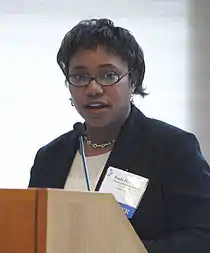Paula T. Hammond
Paula Therese Hammond (born September 3, 1963) is a David H. Koch Professor in Engineering and the Head of the Department of Chemical Engineering at the Massachusetts Institute of Technology (MIT).[1] Her laboratory designs polymers and nanoparticles for drug delivery and energy-related applications including batteries and fuel cells.[2] She is an intramural faculty member of the Koch Institute for Integrative Cancer Research and an Associate Editor of ACS Nano.[3][4]
Paula T. Hammond | |
|---|---|
 | |
| Born | September 3, 1963 |
| Nationality | United States |
| Alma mater | Massachusetts Institute of Technology Georgia Institute of Technology |
| Scientific career | |
| Fields | Biomaterials, Drug Delivery, Cancer immunology |
| Institutions | Massachusetts Institute of Technology |
| Thesis | The Synthesis, Characterization and Optical Properties of Novel Diacetylene-Containing Aromatic Liquid Crystalline Polymers (1993) |
| Doctoral advisor | Michael F. Rubner |
| Other academic advisors | George M. Whitesides |
| Doctoral students | Jodie Lutkenhaus LaShanda Korley |
| Website | https://hammondlab.mit.edu/ |
Early life and education
| External video | |
|---|---|
 | |
Hammond was born in 1963 in Detroit, Michigan[5] as Paula Therese Goodwin to parents Jesse Francis and Della Mae Goodwin (née McGraw). Her father has a Ph.D in Biochemistry and her mother has a master's degree in nursing.[6]
Goodwin graduated a year prior to her expected date at the Academy of the Sacred Heart in Bloomfield, Michigan in 1980.[7] After graduation, Goodwin went on to study and earn a Bachelor of Science in Chemical Engineering from Massachusetts Institute of Technology (MIT) in 1984.[6] After completing her bachelors, she went to work for Motorola for two years as a process engineer in the packaging of integrated circuits.[5][8] She returned to academia and obtained a Master of Science in chemical engineering from the Georgia Institute of Technology in 1988.[6] Hammond master's thesis was on conducting elastomers for robotic tactile sensors.[5][9]
In 1994, she then returned to MIT to receive her Ph.D in chemical engineering in 1994.[6] At MIT she worked under the supervision of Michael F. Rubner. Her Ph.D. thesis research focused on synthesizing polymers with mechanochromic properties.[5] After completing her Ph.D., Hammond was a NSF Postdoctoral Fellow with George M. Whitesides in the chemistry department at Harvard University.
Research and career
In 1995 Hammond was appointed to Massachusetts Institute of Technology as an Assistant Professor.[5] Hammond and her lab design polymers and nanoparticles for applications in drug delivery; wound healing; and energy and fuel cells.[10][11] Much of her work involves layer-by-layer (LbL) assembly, which builds films of alternating positively and negatively charged molecules.[12]
Medical Applications
Hammond has developed "stealth polymers" to disguise cancer chemotherapeutics contained in nanoparticles so that they can reach tumors.[13] She also works on ways to transport RNA into cells to either increase[14] or decrease the expression of specific genes.[15]
Hammond cofounded MIT's Institute for Soldier Nanotechnology, a partnership between MIT, the Army, and industry partners to develop nanotechnology to improve soldier "protection and survivability."[16][8] As part of this program, Hammond designed a spray that helps blood clot to prevent blood loss.[8]
Hammond developed LayerForm™️technology to build drug delivery films with alternating drug and polymer layers. In 2013, co-founded a biotechnology company, LayerBio Inc. to commercialize LayerForm™️ for regenerative medicine applications.[17][11]
Energy and Fuel Cells
Hammond also works on the development of polymers for use in batteries thin films of carbon microtubules that can be used in batteries, solar cells, and fuel cells.[2] She presented research on virus-based batteries to Barack Obama in 2009.[8]
Honors and Recognitions
In 2013, Hammond was one of three African-American female fellows to be elected to the American Academy of Arts and Sciences.
In September 2013, Hammond was recognized by the United States Department of Defense and awarded the Ovarian Cancer Research Program Teal Innovator Award.[18]
- 2019: MRS Turnbull Lectureship Award, Materials Research Society[19]
- 2019: Margaret H. Rousseau Pioneer Award, AIChE[20]
- 2019: Percy L. Julian Award, NOBCChE[21]
- 2019: Fellow of the National Academy of Sciences[22]
- 2018: ACS National Award in Applied Polymer Science[23]
- 2017: Fellow of the National Academy of Engineering[24]
- 2016: Fellow of the American Institute of Chemical Engineers (AIChE)[25]
- 2016: Fellow of the National Academy of Medicine[26]
- 2014: Alpha Chi Sigma Award for Chemical Engineering Research[27]
- 2013: Fellow of American Academy of Arts and Sciences
- 2013: Department of Defense Ovarian Cancer Teal Innovator Award[28]
- 2013: Charles M.A. Stine Award, AIChE[29]
- 2013: Board of Directors, American Institute of Chemical Engineers (AIChE)
- 2013: Margaret Etters Lecturer in Chemistry, University of Minnesota
- 2012: Fellow, American Chemical Society Polymer Chemistry Division[30]
- 2011: David H. Koch Chair Professor of Engineering
- 2010: Top 100 Materials Scientists, top cited as rated by Thomson-Reuters
- 2010: Dow Foundation Distinguished Lecturer, University of California, Santa Barbara
- 2010: Distinguished Scientist Award, Harvard Foundation, Harvard University[31]
- 2009: Melvin Calvin Lecturer, U.C. Berkeley Department of Chemistry
- 2009: Visiting Women's Scholar Award, University of Delaware
- 2009: William W. Grimes Award, AIChE
- 2009: Caltech Kavli Institute Lecturer
- 2009: Fellow, American Institute of Medical and Biological Engineering (AIMBE)[32]
- 2009: Visiting Women's Scholar Award, University of Delaware
- 2008: Karl Kammermeyer Distinguished Lecture at Iowa State University
- 2008: Irwin Sizer Award for Significant Improvements to MIT Education
- 2008: Featured in “Top 100 Science Stories of 2008”, Discover Magazine, for micropatterned virus batteries
- 2007: Lucy Pickett Lecturer, Mt. Holyoke College
- 2006: Bayer Chair Professorship, 2006-2010
- 2006: Popular Mechanics Breakthrough Award for Virus-Based Thin Film Battery
- 2006: Member, National Research Council Board on Chemical Sciences and Technology, 2006-2009
- 2006: Permanent Member, NIH Gene and Drug Delivery Study Group, 2006-2010
- 2004: Georgia Tech Outstanding Young Alumni Award
- 2004: Bayer Distinguished Lecturer
- 2004: Henry Hill Lecturer Award, NOBCChE
- 2003: Radcliffe Institute Fellow (aka Bunting Fellow), Harvard University
- 2002: Henry Hill Lecturer Award, NOBCChE[33]
- 2000: Junior Bose Faculty Award, MIT[34]
- 2000: GenCorp Signature University Award[35]
- 2000: Lloyd Ferguson Young Scientist Award, NOBCChE[36]
- 1997: NSF CAREER Award for Young Investigators[37]
- 1996: Environmental Protection Agency Early Career Research Award[38]
- 1996: 3M Innovation Research Award
- 1996: DuPont Young Faculty Research Award, 1996-1999
- 1995: Herman P. Meissner Career Development Chair 1995-1998
- 1994: NSF Postdoctoral Fellowship in Chemistry
- 1992: Ford Foundation Dissertation Fellowship
- 1992: Massachusetts Institute of Technology Karl Taylor Compton Prize Recipient
- 1990: Eastman Kodak Theophilus Sorrel Graduate Award Recipient, NOBCChE
Selected bibliography
| Library resources about Paula T. Hammond |
| By Paula T. Hammond |
|---|
- Nam, K. T.; Kim, DW; Yoo, PJ; Chiang, CY; Meethong, N; Hammond, PT; Chiang, YM; Belcher, AM (2006). "Virus-Enabled Synthesis and Assembly of Nanowires for Lithium Ion Battery Electrodes". Science. 312 (5775): 885–8. Bibcode:2006Sci...312..885N. CiteSeerX 10.1.1.395.4344. doi:10.1126/science.1122716. PMID 16601154. S2CID 5105315.
- Hammond, P. T. (2004). "Form and Function in Multilayer Assembly: New Applications at the Nanoscale". Advanced Materials. 16 (15): 1271–1293. doi:10.1002/adma.200400760.
- Hammond, Paula T (1999). "Recent explorations in electrostatic multilayer thin film assembly". Current Opinion in Colloid & Interface Science. 4 (6): 430–442. doi:10.1016/S1359-0294(00)00022-4.
References
- "Paula Hammond named head of Department of Chemical Engineering". MIT News. Retrieved 2017-05-11.
- Trafton, Anne. "Harnessing the Power of Polymers". MIT Technology Review. Retrieved 2018-08-18.
- "Editorial Board". pubs.acs.org. Retrieved 2020-08-16.
- "The Koch Institute: Paula T. Hammond". ki.mit.edu. Retrieved 2020-08-16.
- "In Profile: Paula Hammond, Professor of Chemical Engineering at Massachusetts Institute of Technology". Advanced Materials. 14 (2): 95. 2002. doi:10.1002/1521-4095(20020116)14:2<95::AID-ADMA95>3.0.CO;2-X.
- "Paula Hammond". Science History Institute. Retrieved March 21, 2018.
- "Paula T. Hammond '84, PhD '93 | MIT Infinite History". infinitehistory.mit.edu. Retrieved 2020-08-16.
- "The Paula T. Hammond Lab". Science | AAAS. 2014-12-02. Retrieved 2018-08-18.
- Hammond, Paula T (1988). Development of a conductive elastomeric matrix for robotic tactile sensors (Thesis). OCLC 19115234.
- "Paula Hammond". Science History Institute. 2016-06-29. Retrieved 2018-08-18.
- "Paula Hammond on women in science: Life will always be busy; start a company anyway". Chemical & Engineering News. Retrieved 2020-08-16.
- Bourzac, Katherine (2015-12-11). "A Conversation with Paula Hammond". ACS Central Science. 1 (9): 466–467. doi:10.1021/acscentsci.5b00375. ISSN 2374-7943. PMC 4827460. PMID 27163008.
- "Faculty highlight: Paula Hammond". MIT News. Retrieved 2018-08-18.
- "Bio-inspired approach to RNA delivery". MIT News. Retrieved 2018-08-18.
- "Practicing medicine at the nanoscale: New approaches to drug delivery offer hope for new, more targeted treatments". Retrieved 2018-08-18.
- "Institute For Soldier Nanotechnologies - Mission". isnweb.mit.edu. Retrieved 2018-08-18.
- "LayerForm". LayerBio. Retrieved 2018-08-18.
- "FY12 Teal Innovator: Building Better Medicine". US Department of Defense. Retrieved March 5, 2014.
- "David Turnbull Lectureship". www.mrs.org. Retrieved 2020-08-16.
- "Margaret Hutchinson Rousseau Pioneer Award for Lifetime Achievement by a Woman Chemical Engineer". www.aiche.org. 2016-12-05. Retrieved 2020-08-16.
- "Mentoring for excellence at NOBCChE". Chemical & Engineering News. Retrieved 2020-01-18.
- "Three from MIT elected to the National Academy of Sciences for 2019". MIT News. Retrieved 2019-06-18.
- "ACS Award in Applied Polymer Science: Paula T. Hammond". Chemical & Engineering News. Retrieved 2020-08-16.
- "Eight MIT faculty elected to the National Academy of Engineering". MIT News. Retrieved 2017-05-11.
- "Paula Hammond elected a fellow of AIChE – MIT Chemical Engineering". Retrieved 2020-08-16.
- "Paula Hammond elected to the National Academy of Medicine". MIT News. Retrieved 2017-05-11.
- "Paula Hammond - Profile | AIChE Engage". engage.aiche.org. Retrieved 2017-05-11.
- "FY12 Teal Innovator: Building Better Medicine". cdmrp.army.mil. Retrieved 2020-08-16.
- "2013 Charles M.A. Stine Award". www.aiche.org. 2013-06-19. Retrieved 2020-08-16.
- "POLY Fellows". Division of Polymer Chemistry, Inc. 2017-11-29. Retrieved 2020-08-16.
- "Paula T. Hammond wins 2010 Scientist of the Year". Harvard Gazette. 2010-04-15. Retrieved 2020-08-16.
- "Paula Hammond, Ph.D. COF-1171 - AIMBE". Retrieved 2020-08-16.
- "Henry Hill Distinguished Lecture". www.nobcche.org. Retrieved 2020-08-16.
- "MIT School of Engineering | » Teaching Awards". Mit Engineering. Retrieved 2020-08-16.
- "MIT's Dr. Paula Hammond to present this year's Dow Chemical Lecture Series | College of Chemistry". chemistry.berkeley.edu. Retrieved 2020-08-16.
- "Dr. Lloyd N. Ferguson Professional Award". www.nobcche.org. Retrieved 2020-08-16.
- "NSF Award Search: Award#9702752 - CAREER: Control Through Molecular Design in Engineering: Molecular Order and Function from Ionic Multilayers of Liquid Crystal Polymers". www.nsf.gov. Retrieved 2020-08-16.
- "Grantee Research Project Results Search | Research Project Database | Grantee Research Project | ORD | US EPA". cfpub.epa.gov. Retrieved 2020-08-16.